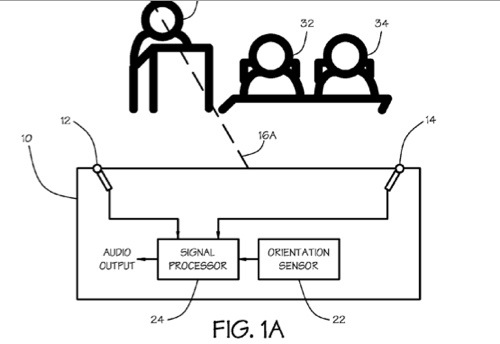I’ve been dubious that Apple would release its own TV set. But a new patent at the US Patent & Trademark Office hints at that. Or it could involve some sort of future Mac or Apple TV accessory.
Patent number 20100128892 involves stabilizing directional audio from a moving microphone array. It relates to the field of audio beamforming; and more specifically, to the aiming of audio beamforming.
The patent involves a device that includes a microphone array fixed to the device. A signal processor produces an audio output using audio beamforming with input from the microphone array. The signal processor aims the beamforming in a selected direction. An orientation sensor–such as a compass, an accelerometer, or an inertial sensor–is coupled to the signal processor. The orientation sensor detects a change in the orientation of the microphone array and provides an orientation signal to the signal processor for adjusting the aim of the beamforming to maintain the selected direction.
The device may include a camera that captures an image. An image processor may identify an audio source in the image and provide a signal adjusting the selected direction to follow the audio source. The image processor may receive the orientation signal and adjust the image for changes in the orientation of the camera before tracking movement of the audio source. The inventors are Shaohai Chen, Phillip George Tamchina and Jae Han Lee.
Here’s Apple’s background and summary of the invention: “Under typical imperfect conditions, a single microphone that is embedded in a mobile device does a poor job of capturing sound because of background sounds that are captured along with the sound of interest. An array of microphones can do a better job of isolating a sound source and rejecting ambient noise and reverberation.
“Beamforming is a way of combining sounds from two or more microphones that allows preferential capture of sounds coming from certain directions. In a delay-and-sum beamformer sounds from each microphone are delayed relative to sounds from the other microphones, and the delayed signals are added. The amount of delay determines the beam angle–the angle in which the array preferentially ‘listens.’ When a sound arrives from this angle, the sound signals from the multiple phones are added constructively. The resulting sum is stronger, and the sound is received relatively well. When a sound arrives from another angle, the delayed signals from the various microphones add destructively–with positive and negative parts of the sound waves canceling out to some degree–and the sum is not as loud as an equivalent sound arriving from the beam angle.
“For example, if the sound comes into the microphone on the right before it enters the microphone on the left, then you know the sound source is to the right of the microphone array. During sound capturing, the microphone array processor can aim a capturing beam in the direction of the sound source. Beamforming allows a microphone array to simulate a highly directional microphone pointing toward the sound source. The directivity of the microphone array reduces the amount of captured ambient noises and reverberated sound as compared to a single microphone. This may provide a clearer representation of a speaker’s voice.
“A beamforming microphone array may made up of distributed omnidirectional microphones linked to a processor that combines the several inputs into an output with a coherent form. Arrays may be formed using numbers of closely spaced microphones. Given a fixed physical relationship in space between the different individual microphone transducer array elements, simultaneous digital signal processor (DSP) processing of the signals from each of the individual microphones in the array can create one or more ‘virtual’ microphones.
Different algorithms permit the creation of virtual microphones with extremely complex virtual polar patterns and even the possibility to steer the individual lobes of the virtual microphones patterns so as to home-in-on, or to reject, particular sources of sound. Beamforming techniques, however, rely on knowledge of the location of the sound source. Therefore it is necessary to aim the beamforming at the intended sound source to benefit from the use of a microphone array. It would be desirable to maintain the aim of the beamforming when the microphone array is part of a mobile device.
“A device includes a microphone array fixed to the device. A signal processor produces an audio output using audio beamforming with input from the microphone array. The signal processor aims the beamforming in a selected direction. An orientation sensor–such as a compass, an accelerometer, or an inertial sensor–is coupled to the signal processor. The orientation sensor detects a change in the orientation of the microphone array and provides an orientation signal to the signal processor for adjusting the aim of the beamforming to maintain the selected direction.
“The device may include a camera that captures an image. An image processor may identify an audio source in the image and provide a signal adjusting the selected direction to follow the audio source. The image processor may receive the orientation signal and adjust the image for changes in the orientation of the camera before tracking movement of the audio source.”

